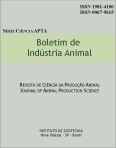Reproductive parameters on hair sheep (Morada Nova and Santa Inês) reared in intensive systems in Southeastern Brazil
Keywords:
prolificacy, reproduction, sheepAbstract
In southeastern Brazil, the Santa Inês ewes is one of the most used to produce early slaughtering crossbred lambs. The Morada Nova breed is reared only in some regions of Brazil and has a very small number of animals and flocks, but ewes have potential to be used for lamb production in the southeast, due to their adaptability to tropical conditions. This experiment aims to evaluate the reproductive potential of Morada Nova ewes to produce early lambs for slaughter. The study was carried out at Instituto de Zootecnia, city of Nova Odessa, located in São Paulo State, Brazil. Forty-nine adult Santa Inês (SI) ewes with 51.8 ± 7.07 kg of initial body weight and forty-nine Morada Nova (MN) with 33.1 ± 4.98 were used. During pregnancy the ewes were reared on intensive grazing systems with rotational grazing on Aruana grass pasture (Panicum maximum cv.IZ-5), and in the final third of gestation received corn silage ad libitum and a concentrate mixture (400 g/day) with 16% crude protein and 80% of total digestible nutrient (TDN). The length of pregnancy, calculated through the date of mating and date of birth; prolificacy rate obtained by the number of lambs born per ewes; percentage of multiple births (%) and ewe€™s weight at lambing (kg) were calculated. Statistical analysis was carried using GLM procedure of SAS ®. The birth weight of MN ewes was lower than the SI ewes, which is a reflection of their smaller size, however, the other reproductive parameters were similar between genotypes. These results highlight the potential use of Morada Nova ewes, as smaller maternal breed, for lamb production, which is favorable for production system that seeks sustainable intensification and optimization of resources, especially food.Downloads
Downloads
Published
Issue
Section
License
Os autores não serão remunerados pela publicação de trabalhos, pois devem abrir mão de seus direitos autorais em favor deste periódico. Por outro lado, os autores ficam autorizados a publicar seus artigos, simultaneamente, em repositórios da instituição de sua origem, desde que citada a fonte da publicação original seja Boletim de Indústria Animal. A revista se reserva o direito de efetuar, nos originais, alterações de ordem normativa, ortográfica e gramatical, com vistas a manter o padrão culto da língua e a credibilidade do veículo. Respeitará, no entanto, o estilo de escrever dos autores. Alterações, correções ou sugestões de ordem conceitual serão encaminhadas aos autores, quando necessário. Nesses casos, os artigos, depois de adequados, deverão ser submetidos a nova apreciação. As opiniões emitidas pelos autores dos artigos são de sua exclusiva responsabilidade. Todo o conteúdo deste periódico, exceto onde está identificado, está licenciado sob a Licença Creative Commons Attribution (CC-BY-NC). A condição BY implica que os licenciados podem copiar, distribuir, exibir e executar a obra e fazer trabalhos derivados com base em que só se dão o autor ou licenciante os créditos na forma especificada por estes. A cláusula NC significa que os licenciados podem copiar, distribuir, exibir e executar a obra e fazer trabalhos derivados com base apenas para fins não comerciais.













